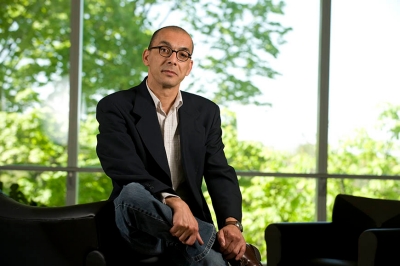Villanova Engineering Professor Turns Wastewater Byproducts into Renewable Energy

: Professor Metin Duran, PhD, Civil and Environmental Engineering
Shares Local Success Story on International Stage
Villanova University Civil and Environmental Engineering Professor Metin Duran, PhD, recently presented a webinar for the Global Methane Initiative in the area of biogas recovery in the wastewater sector. His presentation, “How the Philadelphia Water Department (PWD) Moved from Flaring their Methane to a Co-generation Plant with 5.6 MW Power Generation,” is a prelude to the talk he will deliver at a technical session during the Global Methane Forum in Washington, D.C. in March, 2016.
Director of the College’s Environmental Microbiology and Biotechnology Laboratory (EMB), Dr. Duran’s research concentrates on the application of biological processes for wastewater treatment and water quality control. His work with PWD began more than a decade ago and has included of a number of studies, each with an eye toward developing technologies that convert wastewater byproducts into renewable energy. In 2010, Dr. Duran’s team investigated the conversion of fats, oils, and grease (FOG) —present in wastewater—into methane gas. Anaerobic co-digestion was determined to be the most efficient and economically feasible way to convert FOG into a renewable energy source.
In 2012, the utility company commissioned the design and construction of a new biogas-burning cogeneration plant to produce renewable energy for the region. “The results of several of our research projects played a key role in their decision,” says Dr. Duran. In addition to establishing the feasibility of FOG for generating methane gas, the EMB team investigated the co-digestion of aircraft deicing fluid runoff from the Philadelphia International Airport. By using both FOG and airport runoff as additional feedstock to naturally occurring methanogenic microbes, the water department’s common biosolids digestion process was improved.
PWD’s co-generation plant converts the methane resulting from the anaerobic microbial digestion process into electricity on a mass scale, capable of generating 5.6 megawatts of electricity and thermal energy that the utility can re-use. The water department estimates the project will save $12 million in energy costs over 16 years, and will also keep additional tons of biosolids and FOG out of landfills.
Dr. Duran will share the information presented during the webinar with Global Methane Forum’s international audience how to find sources and test for methane potential. He will present the processes involved and how much methane is needed to make the endeavor economically feasible.
Global Methane Initiative
Launched in 2004, the Global Methane Initiative (GMI), “promotes cost-effective, near-term methane recovery through partnerships between developed and developing countries, with participation from the private sector, development banks, and nongovernmental organizations.” GMI is the only international effort to specifically target methane abatement, recovery and use by focusing on the five main methane emission sources: agriculture, coal mines, municipal solid waste, oil and gas systems, and wastewater. The reduction of methane reduces greenhouse gases, increases energy security, enhances economic growth, improves air quality and improves worker safety.
